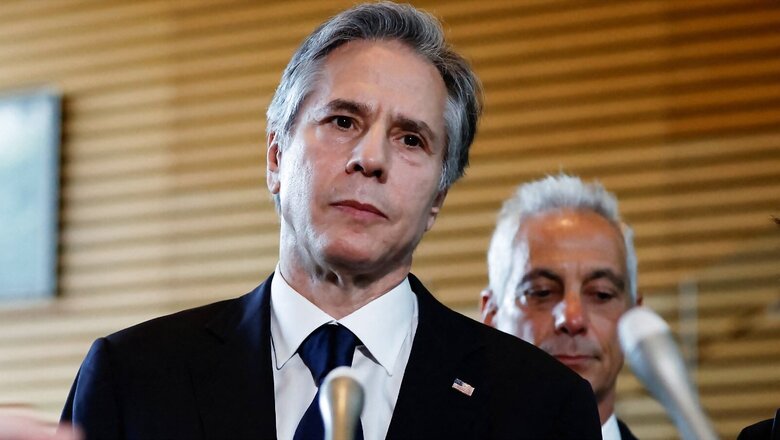
views
The year 2022 was quite turbulent for West Asia with the levels of violence being the highest in the last five years. At least 225 Palestinians and 15 Jews were killed in violent incidents, including innocent civilians and children. At the beginning of 2023, there was no respite in violent incidents and killings on both sides in the occupied West Bank. The deaths of 35 Palestinians and seven Jews took place in the month of January itself.
On 26 January, an Israeli Army operation, targeting alleged Islamic Jihad militants, resulted in the death of 10 people in the Jenin refugee camp. A Palestinian gunman on 27 January killed seven Jews outside a synagogue in occupied East Jerusalem. The very next day, a young teenage shooter injured three Jews. The houses of both assailants have been sealed off by the Israeli military and will be destroyed shortly.
The three-day visit of US Secretary of State Antony Blinken, to West Asia, at the end of January, was aimed at reducing the tensions while attempting to find a permanent solution to the Palestinian homeland problem. Blinken also discussed the ongoing war in Ukraine and the strategic challenges to the region because of the Iranian nuclear programme. The visit started with a meeting with Egypt’s President, Abdel Fattah El-Sisi, who had brokered peace between Palestinians and Israelis last year and remains a strategic partner of the US in bringing peace to the region.
Tens of thousands of Israelis gathered Saturday for a weekly demonstration against Prime Minister Benjamin Netanyahu’s government. The protest is the fifth against the new government, a coalition of ultra-Orthodox and far-right nationalist parties that took office in December. The controversial visit of the ultra-Orthodox far-right leader Itamar Ben Gvir, the kingmaker of Israel, after swearing in as the Minister for National Security, to the Temple Mount in the Al-Aqsa Mosque compound added fuel to fire. Ben Gvir lived up to his manifesto wherein he had stressed on Jews getting their freedom and right to pray at the Temple Mount and not restrict themselves to the outer boundary of the complex and pray only at the Western Wall (Wailing Wall).
Blinken’s visit to West Asia was planned to take understanding from the newly elected Israeli government and the Palestinian Authority to keep the levels of violence under threshold levels but the spurt in violence by both sides has made Blinken’s task much more difficult. Netanyahu, in his two earlier tenures as PM, overlapping with the Obama Administration had shown defiance to the US peace overtures and had continued with building new settlements in the occupied West Bank and East Jerusalem. As per the UN Resolution 181 (II)of 1947, the General Assembly decided to partition Palestine into two states, one Arab and one Jewish, with Jerusalem placed under a special international regime. West Bank and Gaza were to go to Arabs and the rest of the areas to the newly formed state of Israel. The two million refugees (now grown into six million) who had gone to neighbouring states of Jordan, Syria and Lebanon were to return to their homeland.
The Trump administration, through Trump’s son-in-law and special envoy Jared Corey Kushner, an American Jew, had given tacit support to the Israelis in ensuring that the two-state theory was given a decent burial. US President Joe Biden has promised to restore diplomatic relations with the Palestinian Authority. It is unlikely for the two nations to have an understanding on the Palestinian issue after the return of Netanyahu and the democratic government headed by Biden, an erstwhile deputy of Barack Obama.
The formation of another Quad in West Asia, in the form of I2-U2 (India, Israel, USA, UAE), for enhancing strategic relationships between members in various fields including trade and sharing of technology, has further placed the Palestinian issue on the back burner. The block, besides addressing the strategic security concerns coming out of the Iranian nuclear programme and the sale of rones by them to Russia, will also promote trade and commerce between the four partners, especially the UAE and Israel.
Blinken’s visit to West Asia ended without any major breakthrough. However, the US Secretary of State was able to reaffirm the US President’s belief in the two-state theory but was not able to affect or reduce the trend of new settlements by Jews in the occupied territories of the West Bank and East Jerusalem. The timing of the pre-planned visit was of great significance as it was able to bring some respite in the levels of violence as concerns of both — the international community and the US administration — have been flagged in meetings with Israeli Prime Minister Netanyahu and Palestinian President Mahmoud Abbas. For enduring peace, both sides need to commit themselves to the status quo at the Al Aqsa complex; with Arabs praying inside and the Israelis along the Western Wall.
Gen IS Singha was the Head of the United Nations Peacekeeping Mission and Force Commander at Golan Heights between Syria and Israel from 2012 to 2015. The views expressed in this article are those of the author and do not represent the stand of this publication.
Read all the Latest Opinions here




















Comments
0 comment